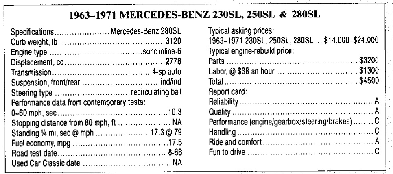 | 330 GT Registry |  |
1963-1971
Mercedes-Benz
230SL, 250SL & 280SL
The image and reputation of Mercedes-Benz in the United States is the envy of all other automakers. Certainly Ferrari and Porsche are held in high esteem by the general public, but more as playthings for the wealthy than as serious transportation. Perhaps that other Teutonic Wunderwagen. BMW, comes closest to matching the Mercedes image, though to many in the general populace the BMW is second best to the car with the 3-pointed star. Mercedes-Benz automobiles are believable. They’re solid. They’re dependable. They’re good investments.
Among our “seven best,” the 230/250/ 280SL is a bit of an oddball. The Mercedes is the reciprocal of the Corvette, for instance. The Sting Ray is a flexible flyer while the SL feels like it was sculpted from a block of stone. The fuel-injected Sting Ray can travel from a standstill to 60 mph in 6.3 seconds and run the quarter mile in 14.4 see, while a 230SL achieves the same tasks in about II sec (yawn) and around 18 sec (z-z-z-z-z). And the Sting Ray has jazzy styling cues like hood scoops and re tractable headlights while the SL is up right, square and functional.
Unlike the Corvette or the rest of the cars on this year’s list, the Mercedes is sensible. But unlike the average Mercedes, it’s not too sensible. The SL has just enough pizazz, just enough quirkiness to make it lovable. The SL came as a convertible, after all, and that isn’t very sensible in this age of noisy traffic jams and smog. It’s a 2-passenger car, not even a 2 + 2.
Today, one of the most endearing aspects of the car is its simple but unique styling. Twenty years ago, just after the 230SL was introduced, R&T called it “understated and ultra-contemporary.” Well it’s hardly ultra-contemporary any longer, but it’s still understated and still handsome. It’s not striking like a Ghibli or voluptuous like an Aston DB5, but it is well proportioned in a chunky sort of way with its flared fenders and wide stance. Styling is also one reason we selected the 230/250/280SLs instead of their successors, the 350/450SLs. Early 350/450SLs are available for under $20,000 now, but they’re heavier and more ponderous looking: Mercedes-Benz engineers even dubbed the cars die Panzerwagen (armored cars) during their development.
Mercedes mechanics tell us, and our owner survey supports them, that with proper maintenance the 230/250/280SL’s engine is good for more than 150,000 miles before overhaul time. This sort of longevity is truly remarkable among sports cars. Owners also report that even after thousands of miles and many years of use, the cars remain tight and rattle-free, another remarkable finding, especially for convertibles.
The 230/250/280SL series, which began in 1963 with the 230SL, uses a sohc 6-cylinder engine with a rather complex, though apparently reliable, Bosch mechanical fuel-injection system. The cars’ single-pivot swing-axle independent rear suspension provides a marvelously supple ride, but it doesn’t give the adhesion of a more modern or sophisticated irs when cornering. For 1967, engine displacement was increased from 2.3 to 2.5 liters, and this model was called the 250SL. The 250SL also received front disc brakes in place of the 230’s drums. A year later, there was another displacement increase, to 2.8 liters, and, of course, this model was called the 280SL.
Aside from these displacement in creases and the disc brakes, there were no changes of great consequence during the 8-year model run. Leather upholstery and an excellent power assisted steering were options. A curious 4-speed automatic transmission was also an option; from a standstill, it normally starts in 2nd gear and gives a decidedly lethargic send-off, though it can be manually overidden for a 1st-gear start. This tranny combined with the 2.5-liter engine or the 2.8 is okay, but with the torqueless 2.3-liter engine, it’s not a happy combination. So SLs with a 4- speed or the very rare 5-speed manual transmission are more in demand in the used-car market.
From the beginning, the SL was available as a convertible, as a fixed hardtop coupe, or as a convertible with both hard and soft tops. However, the removable hardtop is heavy. It’s so heavy, in fact, that in our search for a suitable photo subject for this article, we located three nice SLs, but all the owners refused to remove the hardtops for us!

ROAD & TRACK October 1985
Copyright 1985, CBS, Inc.
